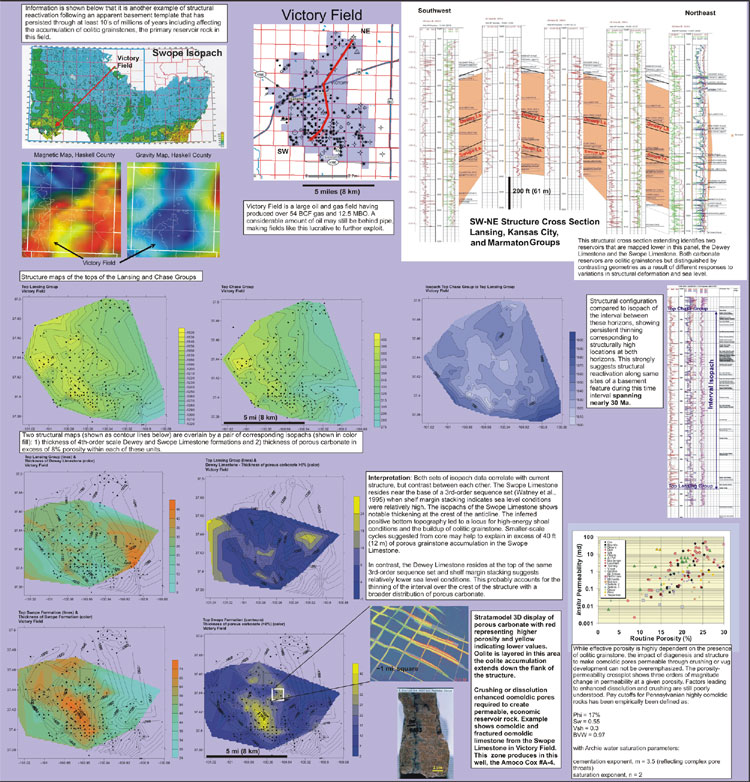Pennsylvanian Field Example - Lower Shelf
Click on above image to see more detail
Summary and Conclusions
Mississippian and Pennsylvanian shelf margin to inner shelf carbonate settings were affected by subtle, but important block faulting and contemporaneous and recurrent tectonism of 1-10's of km on the northern Midcontinent U.S.A.
Structural activity during active foreland basin development has demonstrably impacted reservoir development in shelf areas by creating localized lineaments and faults. The recurring nature of these structures often leads to stacked pays through time. Reservoir types examined range from accumulation of sponge spicule-rich Cowley and Osage Middle Mississippian (in Nichols, Glick, and Spivey Grabs Fields, to oolitic reservoirs in Middle and Upper Pennsylvanian (in Dickman and Victory Fields).
Areas of large to small scale structural reactivation through time are predictable.
Large, prominent, named structures have been often been shown to have antecedent components, but application to extensive shelf segmentation and sedimentation has not been clearly stated or systematically assessed except in a few instances -- Ettensohn et al., 2004 in Ordovician Trenton carbonates along growth faults; measuring “structural gradient” in plains folding (Merriam, 1993); Paleozoic structures of Gerhard (1977,1982, 1987, 2004); Cretaceous seaway structures contemporaneous with deposition (Weimer, 1984; 1986); Lower Carboniferous ramp and links to basement reactivation, Canada (Brandley et al., 1996). As observed in this study, the shelf segmentation extends to smaller systems including play and field scale.
Faulting is closely linked to reactivation of basement lineaments.
Basement geology and geophysics suggest a template of lineaments that apparently represent structural weakness. These weaknesses are apparently more easily strained by nearby and deep-seated tectonic stresses that were active during plate convergence and mountain building in the Pennsylvanian and Mississippian in the Midcontinent U.S.A. Interpretations of potential fields data can provide possible templates for structures that were active at any given time.
Block faulting influenced locations of shelf edges and caused segmentation of the ramp/shelf profile.
Shelf edges are linear and those of the Mississippian and Pennsylvanian closely coincide with one another in south-central Kansas suggesting a common control. Basement lineaments also coincide with the shelf margins and thus are deemed an important control. Block faulting and segmentation of the inner shelf is more difficult to demonstrate due to more subtle deformation and episodic response. Yet, technologies such as 3D seismic can be used to reaffirm recurrent structural growth including that contemporaneous with deposition. Collectively the segmentation ranges in scale from km to 10's of km affecting play characterization and reservoir prediction.
Distinct, localized differences in lithofacies, thicknesses, and stratal architecture occur across faulted segments.
Stratal and lithofacies changes across faults and lineaments can be pronounced and significant at the reservoir scale and important to understand in the development of predictive geologic models. Preferentially preserved, locus areas for thick accumulations of sponge spiculite and oolite reservoir deposits are demonstrated in this investigation. High resolution sequence stratigraphy coupled with 3D seismic can verify high resolution paleogeography.
Sea level, climate, depositional setting, and regional tectonics interacted with local paleotopography affected by contemporaneous structural movements to establish site specific conditions favorable for reservoir development.
Reactivated structures were an important control on depositional patterns, paleotopography, weathering intensity, and movement of fluids.
The recognition of reactivated structural areas and segmentation of the shelf as important elements for reservoir character are improving geomodels and prediction of reservoir quality for development of remaining oil and gas in Mississippian and Pennsylvanian reservoirs in this mature Midcontinent setting.
References
- Blakey, accessed 2005, Global Earth History Website, Paleogeography Through Geologic Time: http://jan.ucc.nau.edu/~rcb7/global_history.html.
- CD-ROM Working Group, 2002, Structure and evolution of the lithosphere beneath the Rocky Mountains--Initial results from the CD-ROM experiment: GSA Today, v. 12, no. 2, p. 4-10.
- Gerhard, L.C., 2004, A new look at an old petroleum province, Kansas Geological Survey, Current Research in Earth Sciences, Bulletin, no. 250, pt. 1
- Gerlach, P.M., 1999, Kansas oil and gas exploration; 10 year history and future strategies: Kansas Geological Survey, Open-file Report, no. 99-55, 17 pages, http://www.kgs.ku.edu/PRS/publication/1999/ofr55/index.html
- Heckel, 1977, Origin of phosphatic black shale facies in Pennsylvanian cyclothems of mid-continent North America: AAPG Bulletin, Jul 1977; 61: 1045 - 1068.
- Kruger, J.M., 1996, On-line gravity and magnetic maps of Kansas, Kansas Geological Survey, Open-file Report, no. 96-51, http://www.kgs.ku.edu/PRS/PotenFld/potential.html
- Longman and Sonnenfeld, 2001, An Introduction to Chert Reservoirs of North America: AAPG Bulletin; January 2001; v. 85; no. 1; p. 1-5.
- USGS, 1995, National Assessment of United States Oil and Gas Resources: Results, Methodology, and Supporting Data: USGS Digital Data Series 30.
- Newell, K. D., Watney, W. L., Chang, S. W. L., and Brownrigg, R. L., 1987, Stratigraphic and spatial distribution of oil and gas production in Kansas: Kansas Geological Survey, Subsurface Geology Series 9, 86 p.
- Van Schmus, W. R., Bickford, M. E., and Zietz, I., 1987, Early and Middle Proterozoic provinces in the central United States; in, Proterozoic Lithospheric Series, A. Kroner, ed.: American Geophysical Union, Proterozoic Lithospheric Series, v. 17, p. 43-68.
- Watney, W.L., Guy, W.J., and Byrnes, A.P., 2000, Characterization of the Mississippian Chat in South-Central Kansas: AAPG Bulletin; January
http://www.kgs.ku.edu/PRS/AAPG2005/controls/p3-07.html
Last Modified January 2006
